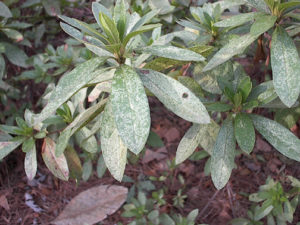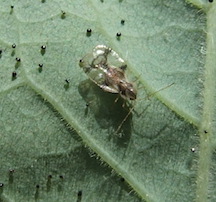
This pest occurs on azaleas, pyracantha, cotoneaster and many other plants. Certain varieties of azaleas are more susceptible than others to this pest. The immature form feeds on the back side of the leaf leaving characteristic black specks from its excrement. The immature form can only be seen with a hand lens or microscope. These are sucking insects and as they feed they remove chlorophyll from the leaf which results in the white specks appearing on the top of the leaf. This damage is very characteristic and differs from chlorosis caused by iron deficiency or yellowing caused by lack of nitrogen. The adults are also extremely small and appear later in the season as small fly like insects with lacy wings, thus the name, though the adults may not be readily noticeable.
 Control: This immature stage of this pest is controlled with systemic insecticides like Imidacloprid or Safari®, while the adultcan be controlled with contact insecticides such as Tempo and Bifenthrin. Spreader-stickers will also increase the efficacy of treatment. Soil nutritional levels and pH must also be correct for recovery.
Control: This immature stage of this pest is controlled with systemic insecticides like Imidacloprid or Safari®, while the adultcan be controlled with contact insecticides such as Tempo and Bifenthrin. Spreader-stickers will also increase the efficacy of treatment. Soil nutritional levels and pH must also be correct for recovery.
